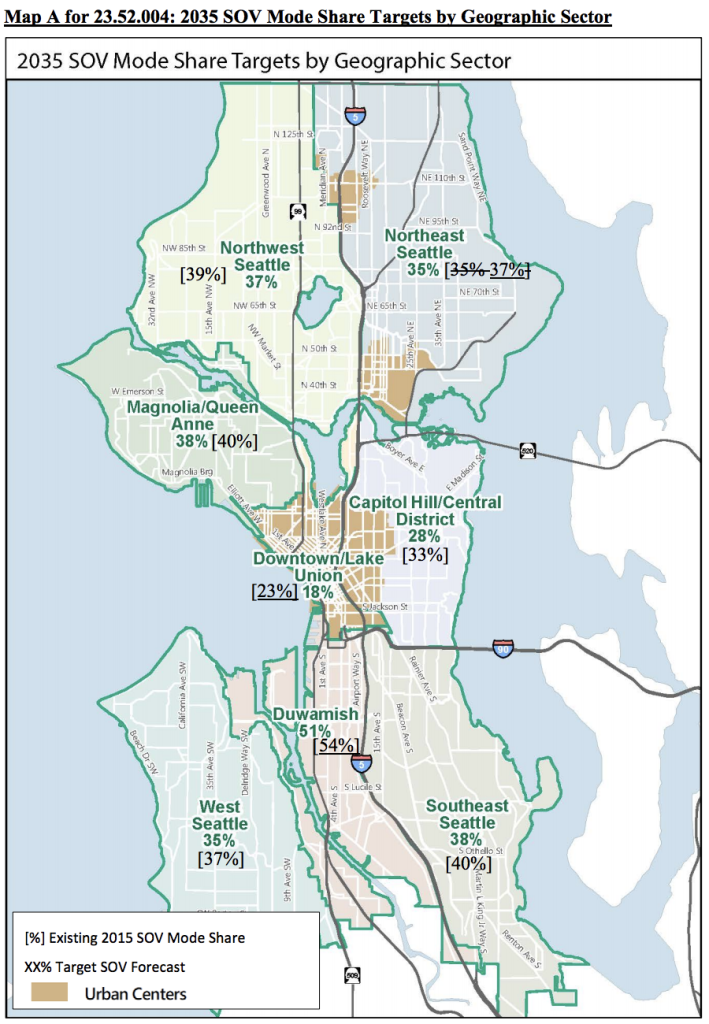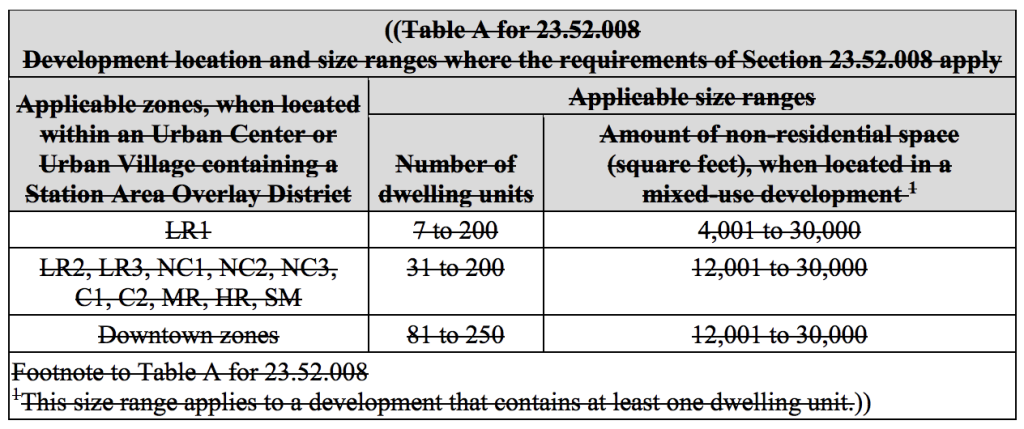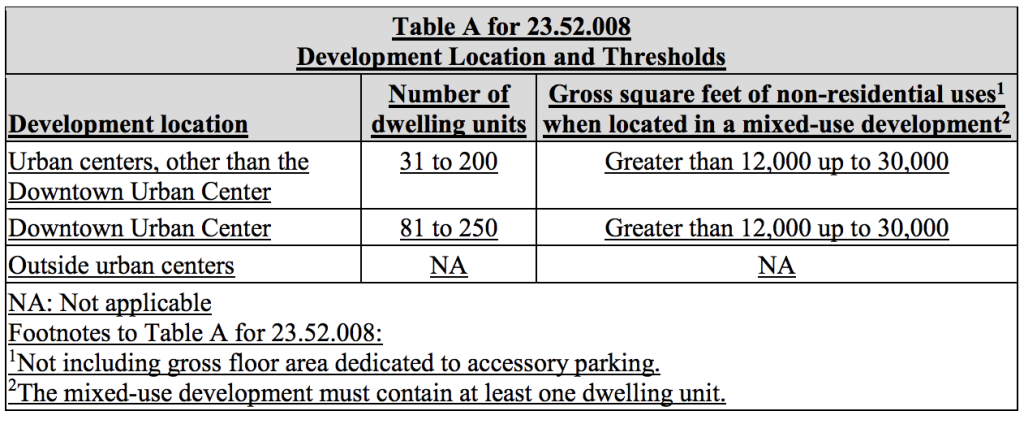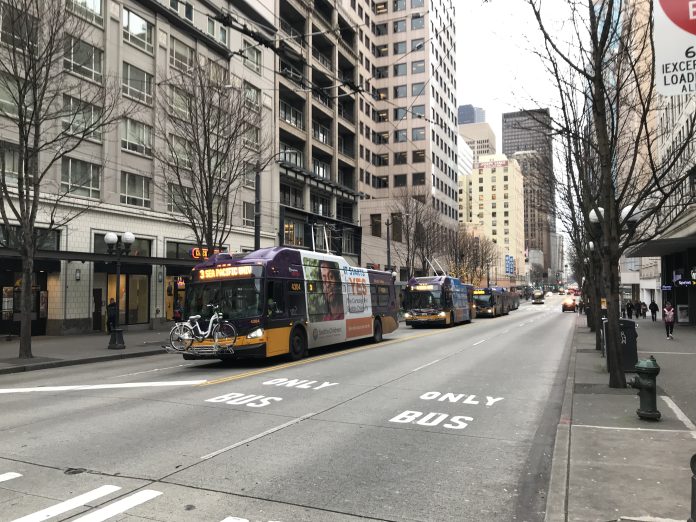On Monday, the Seattle City Council met for a short legislative agenda session. The city council passed a reform bill for transportation level-of-service (LOS) and transportation impact mitigation requirements. The city council also passed a resolution urging Seattle voters to pass Proposition 1 and Proposition 2 in February.
The LOS reform bill will refocus the city’s efforts to mitigate transportation impacts from large development projects to non-single occupancy vehicle investments and tools. If approved by voters, the propositions would reauthorize Seattle Public Schools property tax levies for investments in capital improvement projects and operational programs.
City council shifts paradigm for LOS standards
In 2016, the city embarked on shifting the paradigm for determining level-of-service related to transportation and development impacts on the city’s transportation network. Instead of quantifying local transportation impacts by development projects on individual city street corridors, the city sought to establish targets for transportation modes (e.g., walking, biking, transit, and driving) to be achieved by 2035. A total of eight geographic sectors were identified in the 2016 comprehensive plan update, each with its own target. Generally speaking, sectors specify a lower drive-alone rate than than the baseline 2016 rate.

The adopted legislation will help realize the objectives of the updated comprehensive plan. Developments subject to the LOS standards will need to implement one or more mitigation measures to reduce drive-alone rates, which are to be specified in a new joint directors’ rule by the Seattle Department of Construction and Inspections (SDCI) and the Seattle Department of Transportation (SDOT).
“We in 2016 adopted an update to our comprehensive plan and within that we adopted a level-of-service standard that relies on what the industry would call a ‘multimodal level-of-service’,” Councilmember Rob Johnson said. “It sets a series of targets for reducing the number of folks driving alone living in our neighborhoods throughout the city and sets some goals for those targets.”
“The action we contemplate today would implement those level-of-service standards in neighborhoods throughout the city, and do it in a way that would require residential uses with more than 30 dwelling units, non-residential uses with greater than 4,000 square feet of gross floor area, or non-residential uses in industrial zones that have more than 30,000 square feet of gross floor area to start to propose ideas for folks to able to get to and around those uses without needing to have a car.”
As we reported in December, the legislation will make several significant changes:
- Reduce SEPA exemptions. Projects that are categorical exemption from environmental review under State Environmental Policy Act (SEPA) will no longer be exempt from mitigating impacts related to transportation impacts.
- Methodology for mitigation requirements. Under current regulations, a project that is not categorically exempt from SEPA is only required to proposed transportation mitigation measures if a development proposal is forecasted to generate enough trips to impact the LOS standard of a nearby transportation screenline (an identified corridor). The legislation shifts this paradigm by generally requiring new development to propose transportation mitigation measures to reduce drive-alone rates to achieve the sector target rate if the thresholds that Councilmember Johnson mentioned are met.
- Exempt areas with high access to sustainable transportation options. The legislation does not require transportation mitigation measures if new development is proposed within an Urban Center, Hub Urban Village, or within one-half mile’s walking distance of a light rail station. The idea behind the exemption is that new development would already be located in an area with high access to transit, bike facilities, and mixed uses, which collectively reduce drive-alone trips.
- Revise transportation impact analysis thresholds. In addition to transportation impact mitigation measures related to LOS standards, development projects may be required to conduct a transportation impact analysis (TIA) study depending up the location and size of a project unless subject to SEPA. The legislation revises the thresholds for development projects subject to a TIA and continue to require a menu of specified mitigation measures (e.g., revised access location, wayfinding signage, bicycle parking and shower facilities, and pedestrian improvements) that the SDCI director can impose as conditions. The minimum thresholds for TIAs generally increase and eliminate their applicability to Urban Villages with a Station Area Overlay District.


In December, Councilemember Mike O’Brien had expressed interest in modifying the thresholds for projects subject to LOS requirements. His thinking was that smaller projects should also be subject to mitigation options. No amendment, however, was brought forward during the city council meeting for consideration and adoption, leaving in place thresholds contemplated by SDCI.
Some community members raised concerns during Monday’s meeting about changes that the legislation makes, particularly to Downtown Seattle areas.
“My primary concern as a resident of Downtown is the removal of the Director’s Rule 5-2009,” Ruth Danner said. “That rule requires new construction to consider levels of service for intersections Downtown and when it is removed and replaced with an effort to reduce single occupancy vehicles, but Downtown is exempted because it’s within the half-mile limit for the Link. Downtown we will have no more mitigation. You’ll be adding more parking spaces to parking garages but not counting the cars that will fill them.”
“Please reconsider voting ‘yes’ on the level-of-service standard bill before you,” Meghan Cruise said. “It was written with residential neighborhoods in mind, but in the city center it will compound gridlock.”
The legislation does exempt Downtown zones from contributing to mitigation measures associated with the LOS standards since Downtown zones are located in an Urban Center.
Councilmember Lisa Herbold responded to some comments of concern that were expressed by community members. “Mitigation of transportation impacts for Downtown development as a matter of policy is limited currently to programmatic measures,” she said. “There is SEPA review for Downtown projects and the mitigation that is most often used are Transportation Management Plans. In addition, development regulations in and of themselves create disincentives for single occupancy vehicle use Downtown.”
Continuing her comments, Councilmember Herbold highlighted several examples of development regulations in Downtown that promote lower drive-alone rates as part of development. “There are parking maximums for commercial development,” she said. “There are floor area ratio disincentives for the provision of above-grade parking. There is a development standard where there is a limit of floors of above-grade parking and…requirements regarding screening.”
The joint directors’ rule that Councilmember Johnson mentioned will help implement the legislation. A draft version of the rule has already been shared by SDCI and SDOT. Developers would have a variety of choices to meet the mitigation requirement if the draft rule is adopted. According to SDCI, options would include:
- Pedestrian improvements, specifically sidewalks or curb ramps. These options help complete the city’s pedestrian network and encourage more pedestrian trips from new and existing development. This is especially true if the improvement allows for walking trips that connect to retail or commercial destinations, parks or transit stops that allow people to readily substitute a walking trip for a single occupancy vehicle (SOV) car trip.
- Reduced parking. Developers can reduce the amount of parking that they might otherwise build. Putting parking on a “diet”–not building excess supply–helps reduce the easy availability of parking which can generate SOV trips. Providing less parking in a new building also encourages residents and commercial tenants to use nearby transit options, rideshare, or other travel modes, including ridehailing companies such as Uber or Lyft.
- Mix of land uses. A mix of land uses within a project, such as retail mixed with residential, can directly reduce those SOV trips that would have been needed to travel to another retail shopping area. For instance, a mixed-use project with a convenience store on the ground floor allows someone who lives in the building or nearby to walk to the store.
- Transit pass subsidies. Provision of subsidized transit passes to residents and onsite employees through King County Metro’s ORCA Passport program can directly reduce SOV trips in peak commuting periods by making transit cheaper and/or easier than driving. The passes can also be used outside of peak commuting periods for non-work trips, with the potential of further lowering SOV trips.
- Alternate options to reduce SOV trips. Developers can also propose an option not on the menu by showing it is equally effective in reducing SOV mode share.
The legislation should become law in next two months with the joint directors’ rule following shortly thereafter.
Stephen is a professional urban planner in Puget Sound with a passion for sustainable, livable, and diverse cities. He is especially interested in how policies, regulations, and programs can promote positive outcomes for communities. With stints in great cities like Bellingham and Cork, Stephen currently lives in Seattle. He primarily covers land use and transportation issues and has been with The Urbanist since 2014.


